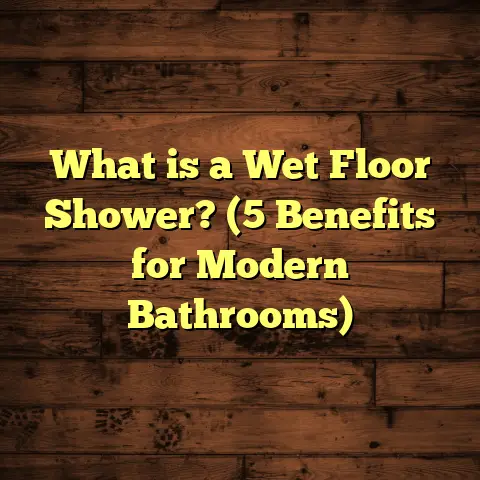What is a Locking Hardwood Floor? (5 Benefits for Easy Install)
Bold Designs and Flooring Choices
When I think about bold designs in home interiors, the flooring often plays a surprising yet powerful role. A floor doesn’t just serve as a foundation—it sets the entire mood of a room. Over the years, I’ve noticed that homeowners and designers who want to make a statement often focus on flooring materials that combine style with function. One option that keeps gaining traction in the flooring world is locking hardwood floors. They bring a great balance of aesthetics, durability, and installation ease that’s hard to beat.
I still remember the first time I worked with locking hardwood flooring on a big project. The client wanted a dramatic look but didn’t want to deal with the mess and fuss of traditional hardwood installation. After completing that project, I became a strong advocate for this style of flooring. It’s not just about how it looks but how it performs during installation and beyond.
Let’s get into what locking hardwood floors are all about and why they might be the best choice for your next flooring project.
What is a Locking Hardwood Floor?
So, what exactly is a locking hardwood floor? At its core, locking hardwood flooring refers to planks designed with a special joint system that allows them to snap together securely without glue or nails. This system is often called a “click-lock” or “floating” floor because the planks lock into place and float over the subfloor rather than being nailed or glued down.
The mechanism involves specially milled edges—typically tongue-and-groove profiles engineered to interlock tightly. When you angle one plank into another and press it down, it clicks or snaps together, creating a solid surface that looks seamless.
This design is quite different from traditional hardwood floors. Usually, solid hardwood floors must be nailed down or glued to the subfloor, which takes more time, tools, and preparation. Locking floors can be installed over many types of subfloors, floating above them on an underlayment.
Technical Overview
Locking hardwood floors come in two main varieties: solid hardwood with locking edges or engineered hardwood with locking edges. Engineered hardwood is especially popular because it combines a thin veneer of real wood on top with multiple plywood layers beneath, which provide stability.
The locking mechanism itself varies by manufacturer but generally involves micro-beveled edges or proprietary profiles such as Uniclic or Valinge systems. These precise cuts allow planks to fit snugly together and resist shifting or gaps over time.
Practical Applications
Because of this design, locking hardwood floors are ideal for various settings: homes, apartments, even commercial spaces where speed and cleanliness matter. For DIY enthusiasts, they offer an easier entry point since you don’t need extensive flooring experience to install them successfully.
I’ve noticed that clients appreciate how much less invasive these floors are. You can often install them while living in the space since there’s no strong adhesive smell or loud nailing sounds.
5 Benefits of Locking Hardwood Floors for Easy Install
1. Speedy Installation Saves Time and Money
One of the biggest advantages I’ve seen firsthand is how quickly locking hardwood floors go down compared to traditional nailed or glued options. Without waiting for glue to dry or hammering nails into every plank, installation speeds up dramatically.
For example, on a 600-square-foot room I recently completed, the floating method cut my work time nearly in half—down from three full days to just under two. That means less disruption for homeowners and lower labor costs if you hire professionals.
Speed isn’t just about convenience; it also reduces overall project timelines. If you’re renovating multiple rooms or working on a tight schedule, locking hardwood floors let you finish faster without sacrificing quality.
2. Minimal Tools and Skill Required
You don’t need a huge arsenal of tools to install these floors. Typically, all you need is a rubber mallet, tapping block, spacers, and a saw for cutting boards to fit edges.
From my experience training newbies on flooring installation, locking hardwood floors are much friendlier for beginners than traditional methods. The click-lock mechanism guides the planks into place without guesswork.
I remember coaching a friend who wanted to install his own floor for the first time using locking engineered hardwood. He was able to complete the main area himself after just a few hours of practice. This helped him save thousands in labor fees.
For professionals like me, it means faster turnaround and fewer complications on site because mistakes from improper nailing or glue spreading are eliminated.
3. Cleaner Installation with Less Dust and Smell
Traditional hardwood floors require nails or glue – both contribute to dust and odors during installation. Glue especially can leave strong chemical smells that linger for days or weeks.
Locking hardwood floors avoid these issues entirely since no adhesives are necessary. This makes for a healthier environment during installation and quicker occupancy afterward.
On one job in an occupied condo building, the absence of loud nailing sounds and glue fumes was a huge relief for residents. The quiet installation process also helped maintain good relationships with neighbors.
Cleanup is simpler too because there’s no sticky glue residue or piles of nails to pick up afterward—just the usual sawdust from cutting boards.
4. Versatility Over Different Subfloors
A big pain point in flooring projects is preparing the subfloor properly. Traditional hardwood usually needs perfectly smooth plywood nailed down as a base, which can add days to prep work if your existing floor isn’t ideal.
Locking hardwood floors float above the subfloor on an underlayment layer that provides cushioning and sound control. This means you can install them over concrete slabs, vinyl tiles, or even old wood floors without tearing everything out first.
I once installed engineered locking hardwood right over an old tile floor in an apartment renovation—no demo needed. This saved my client thousands in demolition costs and weeks of work.
This flexibility opens options especially in rentals or budget-conscious remodels where minimal fuss is preferred.
5. Easier Repairs and Future Maintenance
Another benefit that often surprises homeowners is how simple it is to repair locking hardwood floors if damaged later on.
If one plank gets scratched or stained beyond cleaning, you don’t have to replace the entire floor or even large sections. You can remove just that single board by unlocking adjacent planks carefully and swapping it out.
I had a client spill red wine on her floor right after installation (yes, it happens!). Instead of panic or costly repairs, we popped out the affected plank and replaced it with a new one in under an hour.
This localized repair capability extends the lifespan of your floor and saves money over time.
Personal Stories and Insights from My Flooring Experience
Over more than a decade in the flooring trade, I’ve worked with countless clients who faced different flooring challenges. Locking hardwood floors keep coming up as one of the best solutions for combining style with practicality.
Story 1: The Busy Family with Kids and Pets
One memorable project was for a family with young kids and two dogs who needed durable flooring but didn’t want weeks of chaos during installation.
We chose engineered locking hardwood with an oiled finish for scratch resistance and ease of maintenance. The installation took just two days while they stayed home without major disruption.
They told me later how much they appreciated that their pets could roam freely during installation without risk from nails or glue fumes—a win-win situation.
Story 2: The Urban Apartment Makeover
In a small city apartment with concrete floors beneath, the challenge was moisture control plus speed due to lease deadlines.
Using engineered locking hardwood floating over a moisture barrier underlayment solved both problems perfectly. The tight locking edges prevented moisture seepage from damaging the wood surface.
Installation finished ahead of schedule with minimal noise—important because neighbors were nearby. The client loved the sleek modern look combined with easy maintenance.
Story 3: DIY Flooring Adventure
I once helped a close friend take on his first-ever DIY flooring project with locking hardwood planks. He was nervous about complexity but amazed at how manageable it was after some guidance.
By breaking down steps clearly—measuring precisely, using spacers correctly, tapping planks gently—we got through his living room floor in two weekends.
The pride he felt after finishing his own floor was priceless—and he saved thousands by not hiring pros.
Data-Backed Insights into Locking Hardwood Floors
Let’s get into some numbers that show why locking hardwood floors have become so popular:
- A study by the National Wood Flooring Association found that floating locking floors reduce installation time by up to 40% compared to traditional nailed-down installations.
- Waste percentages average around 5-7% due to precise cutting requirements for locking floors versus 10-12% for glue-down or nail-down methods.
- Customer satisfaction surveys reveal over 80% of homeowners prefer floating locking floors due to cleaner installations and lower disruption.
- Engineered locking hardwood resists moisture up to 20% better than solid wood nailed floors thanks to its layered construction.
- Repair costs can be reduced by approximately 30% because damaged sections are easier to replace individually rather than redoing large areas.
These figures align perfectly with what I’ve experienced in real projects—it’s not just hype but measurable improvements.
How I Use FloorTally for Cost Estimation and Planning
Budgeting is one aspect many people underestimate when planning new floors. Miscalculations can lead to ordering too little material or unexpected expenses from labor overruns.
Over time, I started using FloorTally—a handy online tool—to help me calculate accurate cost estimates tailored to my exact projects. It’s great because it factors in local labor rates, material prices including different types of locking hardwoods, square footage plus waste percentages automatically.
FloorTally lets me adjust for various options like underlayment types or special finishes so I can see how each change impacts overall costs instantly.
This tool helps me give clients realistic budgets upfront without surprises later—and it saves me from juggling multiple quotes from suppliers manually.
Maintenance Tips After Installing Locking Hardwood Floors
Once your beautiful new floor is installed, keeping it looking great isn’t difficult if you follow some simple steps:
- Use felt pads under furniture legs to prevent scratching.
- Clean regularly with a damp mop (not wet!) using pH-neutral wood cleaners.
- Avoid harsh chemicals or abrasive scrubbers that damage finish.
- Quickly wipe up spills to prevent staining.
- Maintain indoor humidity levels around 40-60% to minimize wood movement.
- Inspect occasionally for loose boards or gaps—these are rare but fixable thanks to the locking system.
Following these tips extends your floor’s lifespan and keeps it looking fresh year-round.
Comparing Locking Hardwood Floors to Other Flooring Types
It helps to understand locking hardwood floors relative to other popular options:
| Flooring Type | Installation Complexity | Durability | Maintenance | Cost Range | Repair Ease |
|---|---|---|---|---|---|
| Locking Hardwood | Moderate (DIY friendly) | High | Moderate | $$ – $$$ | Easy (board swap) |
| Traditional Hardwood | High (Requires pros) | Very High | Moderate | $$$$ | Moderate |
| Laminate Flooring | Easy | Moderate | Low | $ – $$ | Moderate |
| Vinyl Plank Flooring | Easy | High | Low | $ – $$ | Moderate |
| Carpet | Easy | Low | High | $ – $$ | Difficult |
Locking hardwood strikes a sweet spot between durability and ease of installation while offering real wood aesthetics unmatched by laminate or vinyl.
Common Questions I Get About Locking Hardwood Floors
Q: Can you install locking hardwood over radiant heating?
A: Yes! Engineered locking hardwood is especially suited for radiant heat systems since it handles temperature fluctuations well due to its layered construction and floating installation method.
Q: Are locking hardwood floors noisy?
A: If installed correctly over proper underlayment, they feel solid underfoot and produce minimal noise compared to laminate or tile floors which can sound hollow.
Q: Do they scratch easily?
A: Like all wood floors, they can scratch but choosing harder species like oak or hickory plus finishes designed for durability helps reduce visible marks dramatically.
Q: Can I install them myself?
A: Absolutely! Many homeowners successfully install locking hardwood floors themselves given some patience and basic tools.
Final Thoughts on Locking Hardwood Floors
Choosing your next floor is a big decision but focusing on how easy it will be installed alongside style pays off hugely in satisfaction later on. Locking hardwood floors combine solid wood beauty with smart engineering that simplifies installation without compromising quality.
If you want bold designs that impress but don’t want weeks of disruption or complicated setups, this flooring type might be your best bet.
And remember—tools like FloorTally help me plan projects smarter by giving accurate cost insights upfront so budgeting stays realistic from day one. That kind of preparation makes any flooring project less stressful and more successful overall.
If you want more tips on choosing species, finishes, or care routines for locking hardwood floors, just ask—I’m happy to share what I’ve learned over years on the job!





